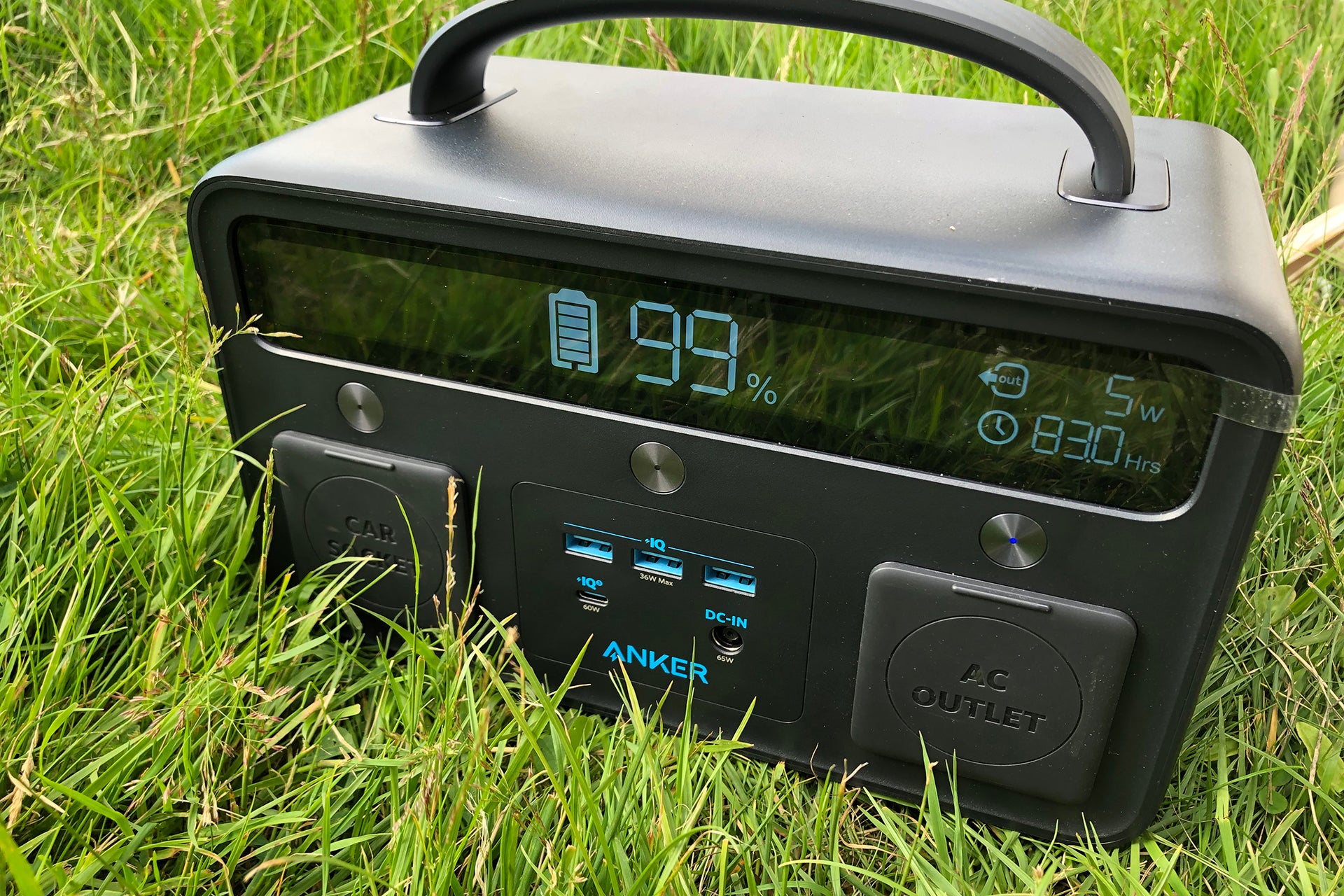Verdict
One of the best power stations, the EcoFlow Delta 2 has a large capacity of 1,024Wh and can be expanded further with additional batteries. Its true power lies in the fact that it can power 90% of household appliances, making it ideal for campers (or those with unstable mains power) who want the creature comforts. With 3,000 charge cycles until it hits 80% capacity, this is also an extremely long-lasting battery.
Pros
- Huge capacity
- Runs most domestic appliances
- Long-lasting
- Expandable
Cons
- Difficult-to-reach buttons when plugs are connected
- Flimsy charging flap
Introduction
Going away from the power grid doesn’t mean that we necessarily want to give up our electrical goods. That’s where the EcoFlow Delta 2 comes in.
I’ve reviewed portable power stations before, but this battery-powered device is one of the most powerful yet: with its 1,024Wh battery and high output, the Delta 2 can cope with pretty much every household appliance, which makes it useful on camping trips, as well as for filling in around the home if there’s a blackout.
Design and Features
- Solar, car and mains charging
- Expandable with additional battery packs
- Powers devices up to 2,400W
I’ve reviewed the EcoFlow River Pro before, but the Delta 2 is a step up from that model in terms of features and its capacity. Coming in at 12kg, the Delta 2 is at the limit of what you can consider portable. I found that the large handles let me lug it from house to car, or from room to room.
The main standout feature is that the Delta 2 supports devices up to 1,800W, with X-Boost technology preventing overloading from devices up to 2,400W. EcoFlow does say that X-Boost technology is best for devices that have less strict voltage requirements, and it’s particularly suitable for heaters.
As a result, this power station can handle more than 90% of household appliances – that’s everything from TVs and laptops to grills and even lower-power kettles. This makes the Delta 2 worthwhile around homes with unreliable power supplies. In fact, I used it for watching TV, roasting coffee and mixing bread with no performance issues.
It helps that this model has four UK power sockets, located at one end, which gives a fair amount of flexibility for what I could plug in. An on/off switch controls these mains outlets, although this is inconveniently placed in the middle of the sockets, so it’s fiddly to reach without unplugging devices. Beneath the sockets are the 12V car power and the dual DC5521 12.6V outputs.
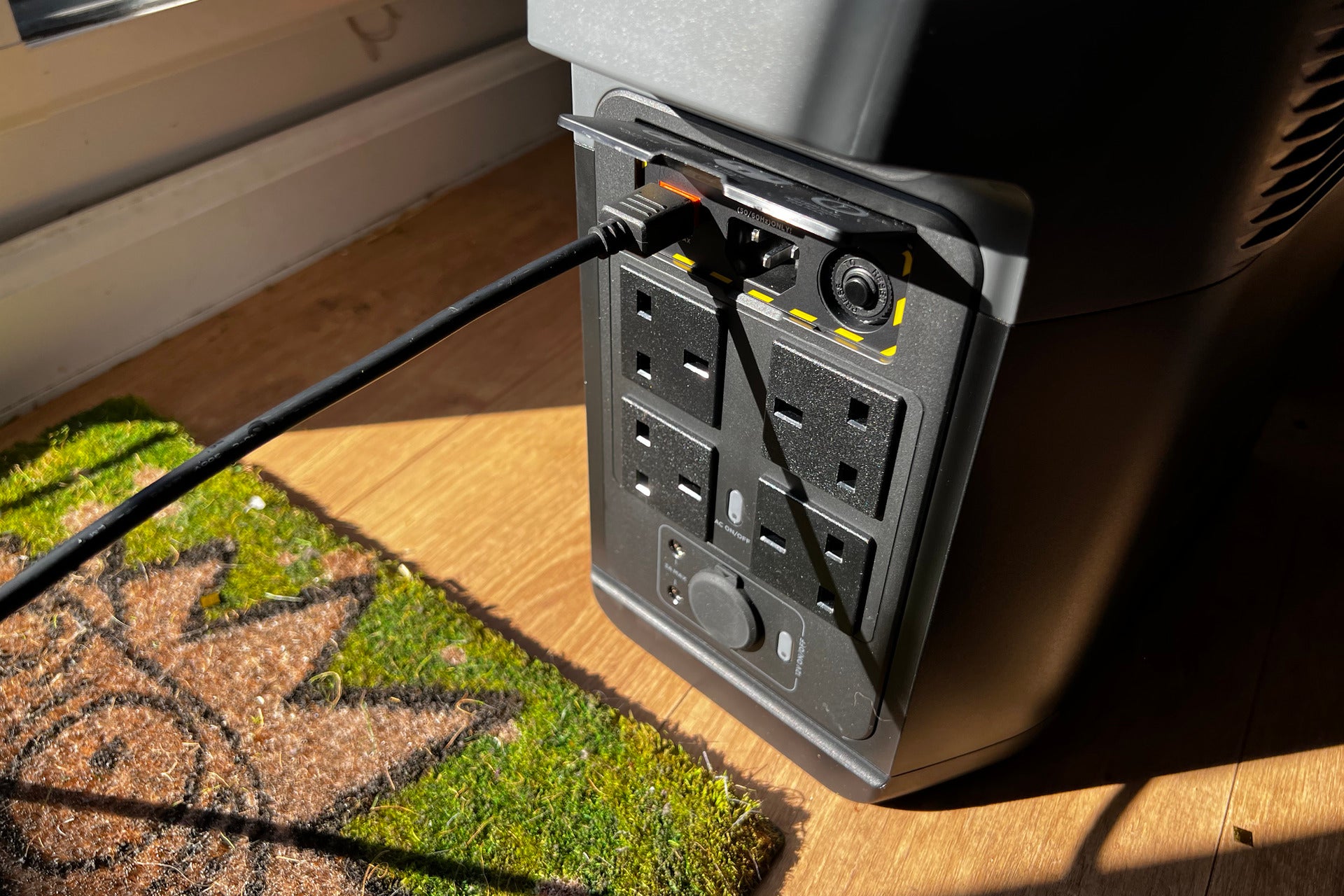
On the other side of the battery pack are the USB ports: two USB-A, two fast-charge USB-A and dual USB-C 100W (good enough for a laptop). Again, these are controlled via an on/off button, although this one is easier to reach.
There’s a master power switch below the USB ports. At the top, you’ll find an LCD that shows the current power draw, input power and the battery time remaining in both hours (calculated by how much energy is going out) and as a percentage.
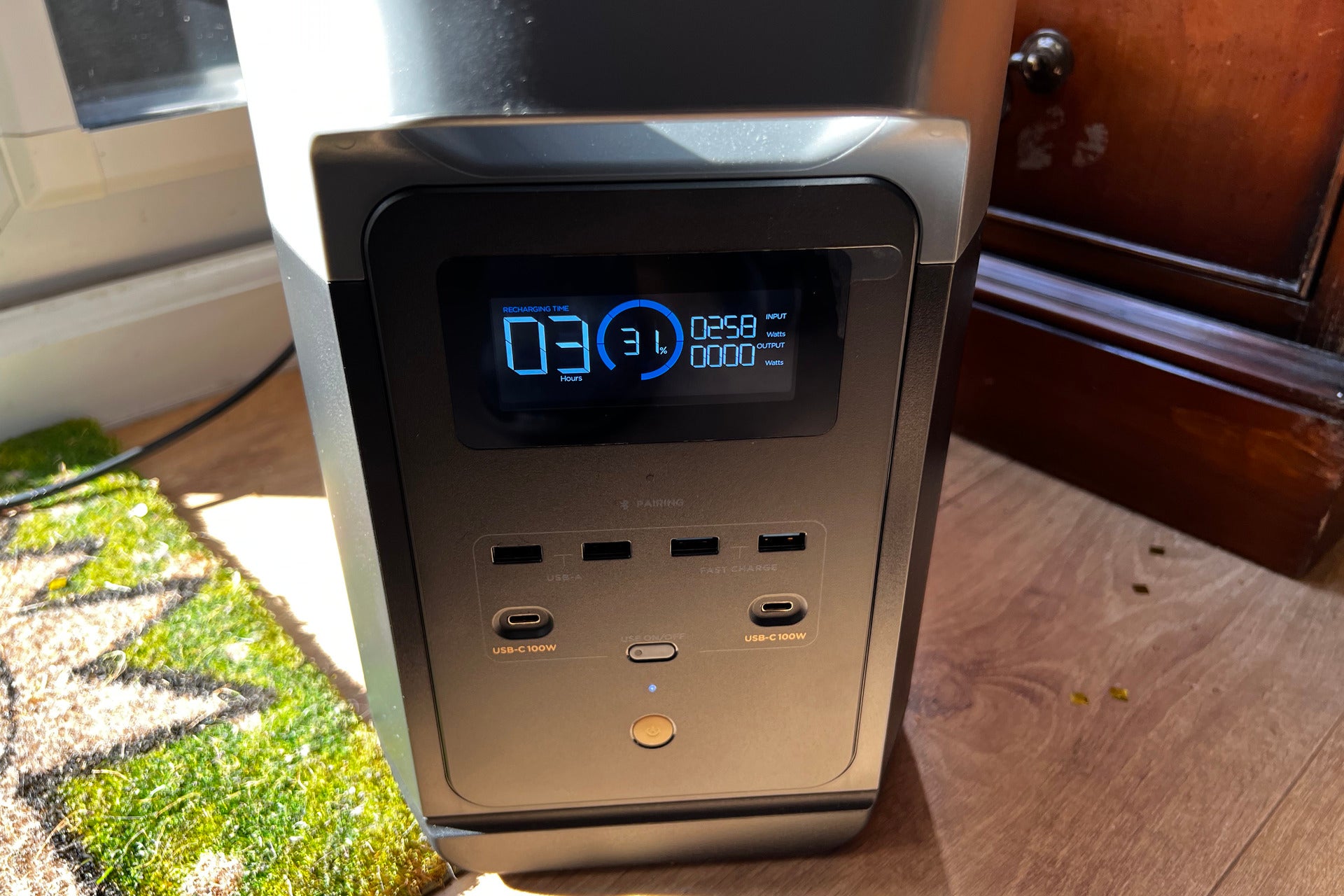
Internally, there’s a 1,024Wh battery, which is just over 1kWh of power. On average, UK homes use between 8kWh and 12kWh of power per day, so the battery here is a chunk of normal use. If you do want to add more power, you can bring in an additional battery pack.
Adding an extra 1,024Wh costs £749 for the EcoFlow Delta 2 Extra Battery, whereas the Delta Max Extra Battery is £1,499 more.
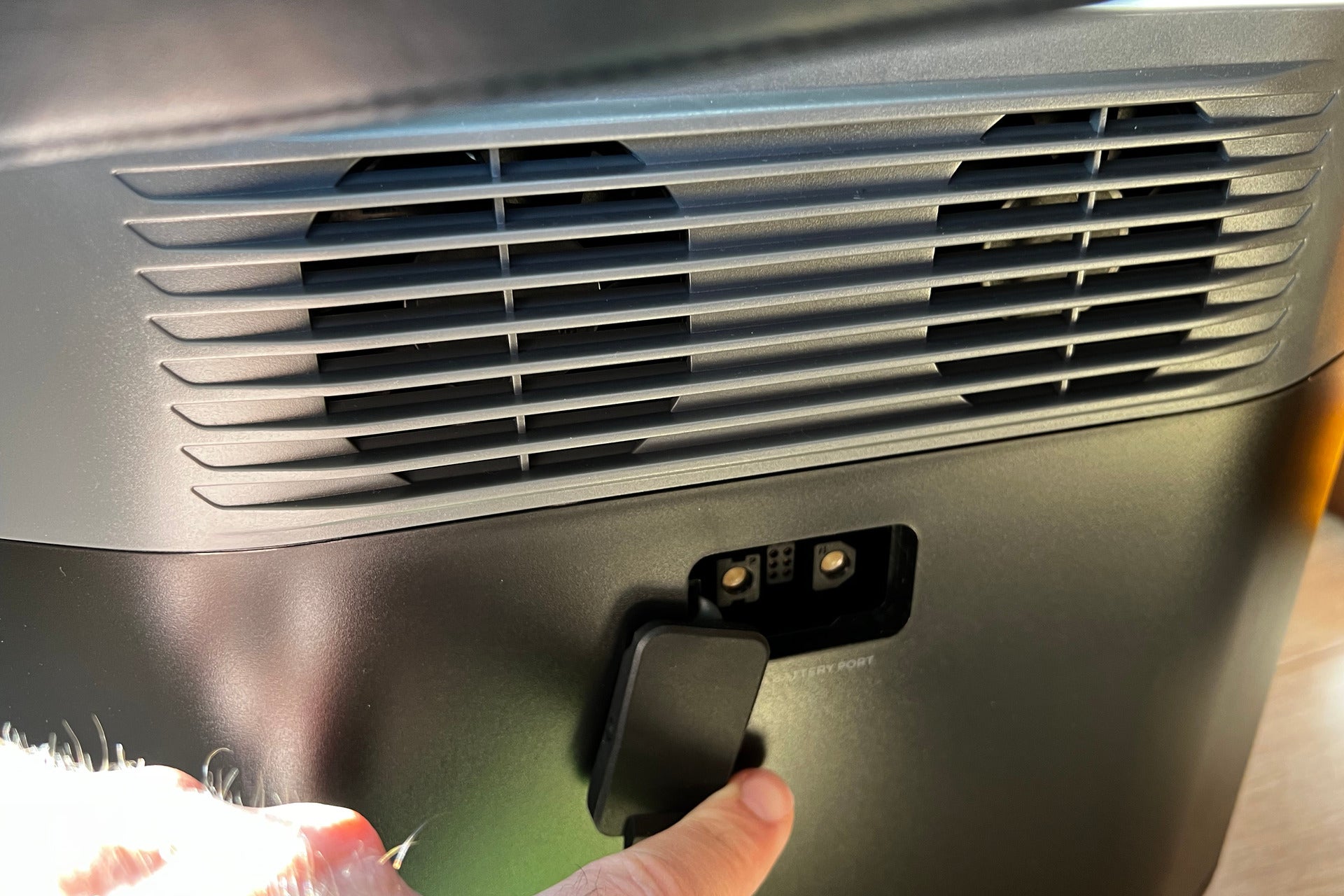
Using LFP battery tech (as used in Tesla cars), both the Delta 2 and its additional batteries last for 3,000+ charging cycles. That’s a chunk more than the competition, and it means that if the battery was charged and discharged daily, it would last for more than 10 years.
Charging inputs are on the side of the battery opposite the screen, just above the regular power sockets. As with the River Pro, the inputs are hidden under a little flap, which feels a bit more flimsy compared with the robust build quality of the rest of the unit.
The standard kettle lead input draws power from the mains. With 1,200W of charging, this battery can be topped up in 80mins, while an 80% charge takes just 50mins. This was handy when I needed maximum power in the shortest amount of time.
If you’re on a smart meter with a cheaper off-peak tariff, it’s worth charging the Delta 2 at night, so you can store the cheap power and use it when it’s convenient.
Alternatively, this power station can be charged via its 12/24V input, so it can be topped up from a car. Likely to be more useful is the solar input, which can take a maximum of 500W (more on this later).
As well as operating as a battery, the Delta 2 can be an emergency power supply (EPS). Leave it plugged into the mains, and if there’s a power cut, it will switch to battery power automatically, keeping key devices, such as a computer and monitor, running.
Just like the River Pro, the Delta 2 can connect to a 2.4GHz network. Once hooked up, the app shows you the current load (input and output), plus it has switches to toggle the mains sockets, USB ports and 12V car output. Using the app also gives a few extra features, such as control over the target charge level and the discharge point at which the Delta 2 will stop outputting power.
Solar Charging
- Takes up to 500W of power
- Can charge in 3-6hrs
It’s not always possible to find a power plug, but with a solar panel input, the EcoFlow Delta 2 can be charged almost anywhere. This power station can work with one or two 220W solar panels (EcoFlow ones cost £549 each) or the larger 400W (£999), which I have on review.
The 400W panel is a beast of a device, folding down into a very large carry bag. At 19kg, the solar panel is heavier than the Delta 2 itself.
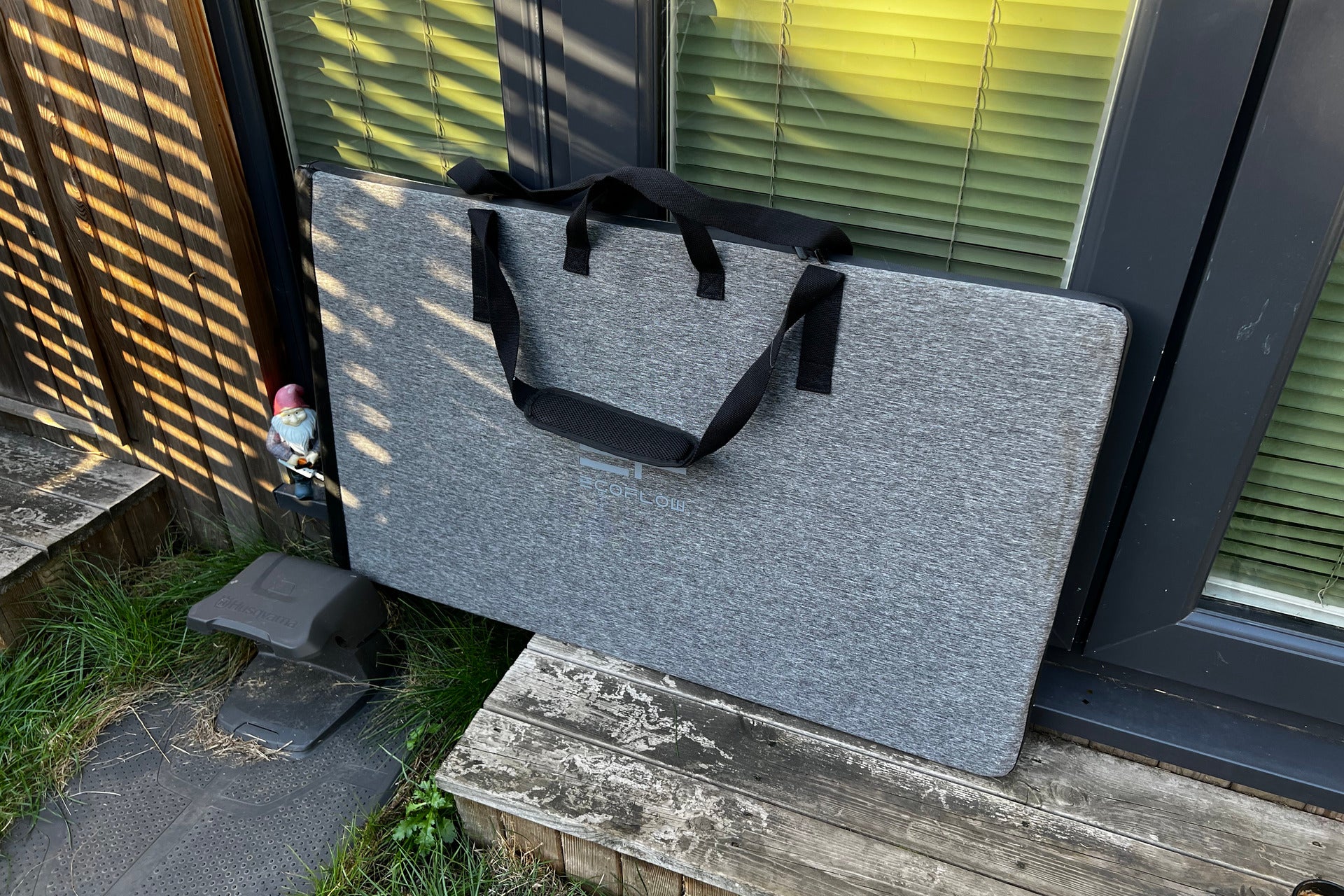
This bag also acts as a kickstand, keeping the four panels at the right angle to pick up sunlight.
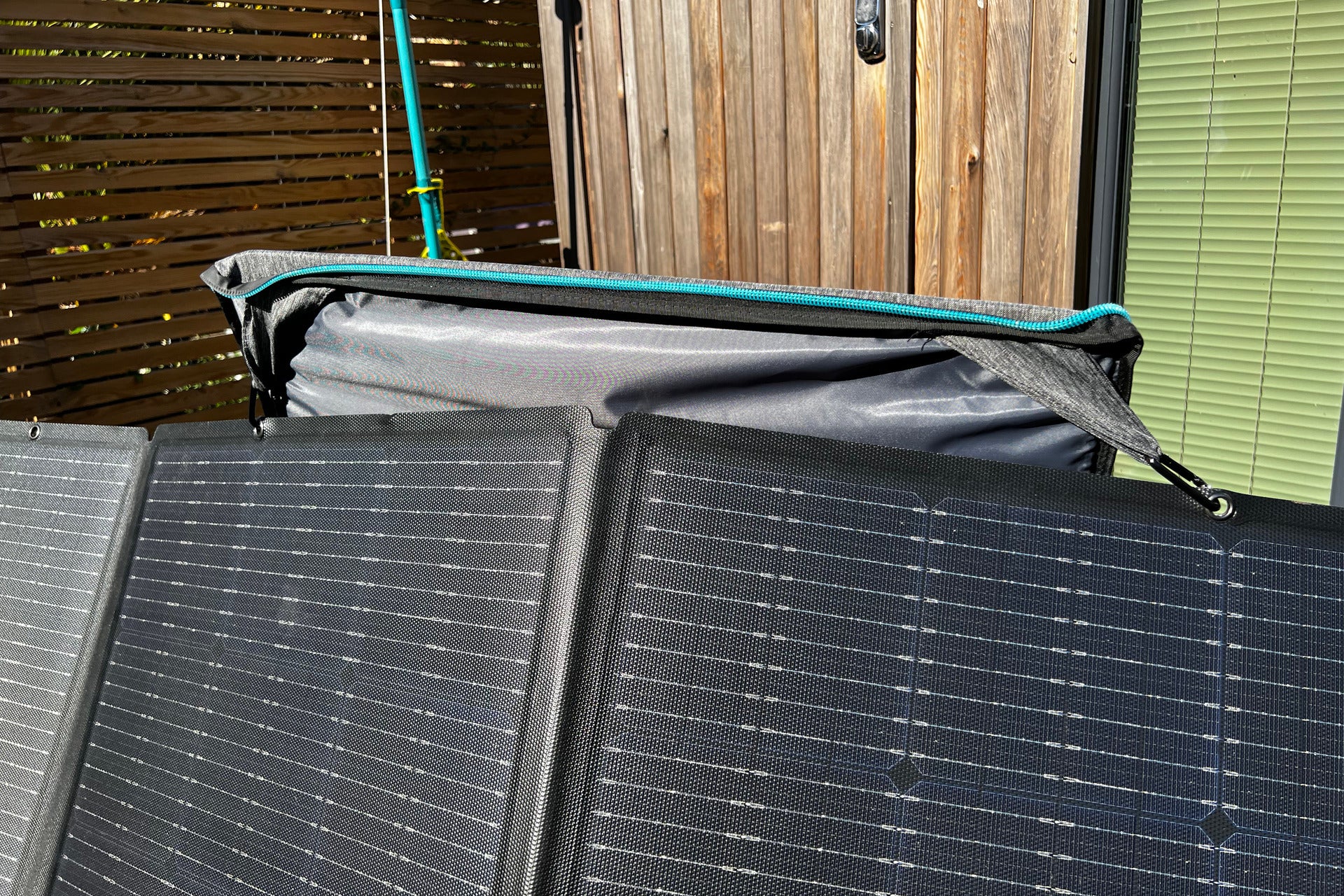
I needed a lot of space to get the panels laid out: at 236.5cm wide, the 400W solar panel is about half the width of my terraced garden.
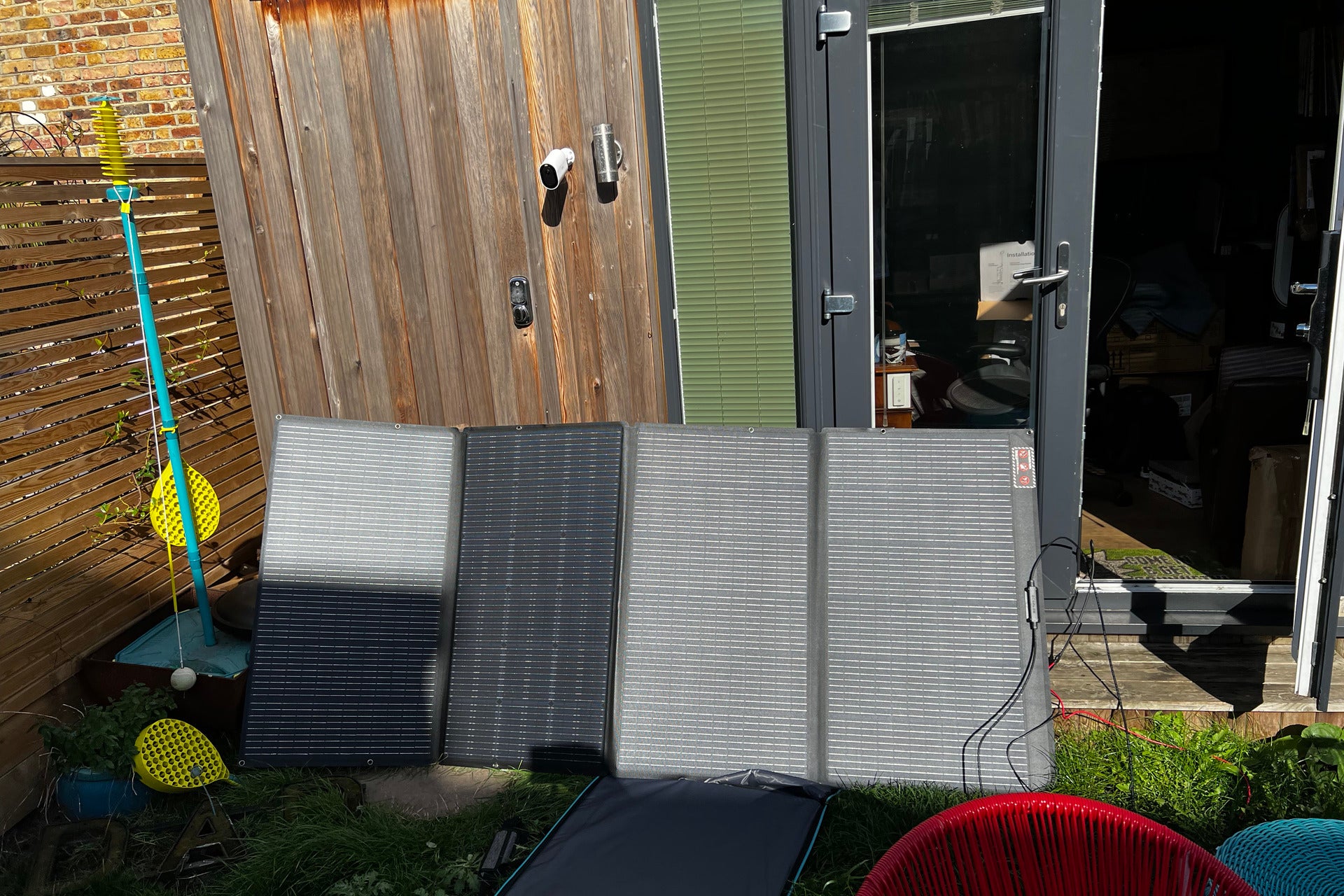
Connected up on a bright and sunny day, the solar panel peaked at 295W, which would charge the battery in less than 4hrs. However, when the sun went behind a cloud, the solar input dropped to just 31W, and a full charge would have taken about 34hrs.
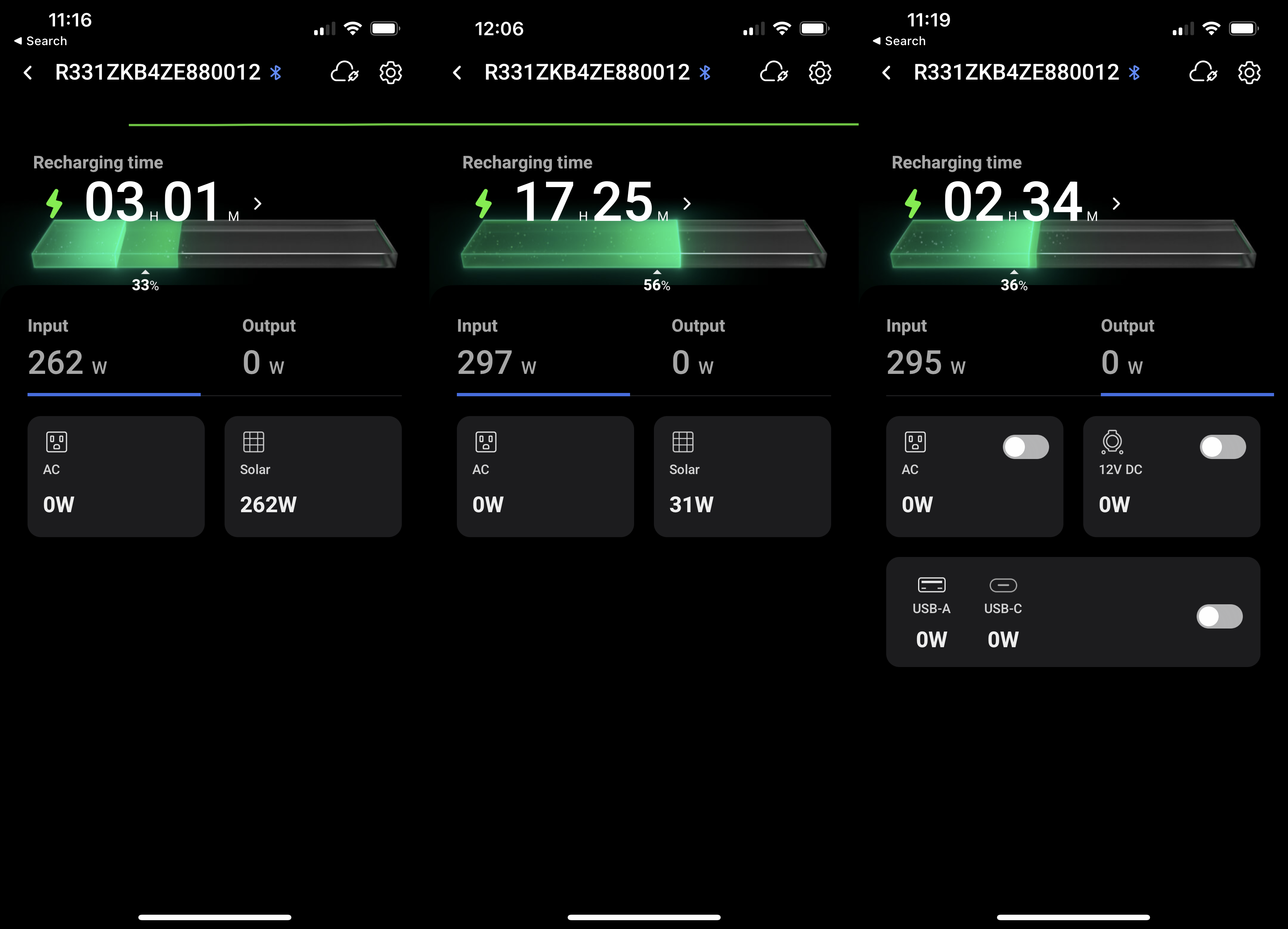
Based on this, the solar panel is far more useful in the long summer months than in the short winter days, particularly when it’s often overcast. Still, for those who love camping or are looking to go off-grid, the 400W panel is big and quite expensive, but it does give the best chance for fully topping up the battery away from mains power. That in itself could make it a worthy upgrade.
Performance
- Handles almost any device
- Long-lasting power
I put the EcoFlow Delta 2 through a range of tests to see what it’s capable of. First, I loaded it up with my TV setup: a 55-inch OLED TV, a Sonos Ray soundbar and a Sky Q Mini box. All in all, I could have had about 8hrs of viewing on a single charge.
I watched content for a few hours, then roasted two lots of coffee beans using a home roaster and mixed three lots of bread in a Thermomix TM6 (all of this was over a period of a few days). The Delta 2 managed to cope with all of it on a single charge, with some power even left over.
With less demanding applications, 1kWh will go a long way. According to Ecoflow, it’s 31hrs of a 10W light, 16 charges of a 60W laptop, 89 charges of a typical phone, and up to 32hrs of a typical car fridge.
Of course, stick something more power-hungry into it, such as a 1,800W grill, and there’s just enough power to get about 30mins of cooking time (quite possibly enough to do something simple at a pinch).
Pair the Delta 2 with a more gentle heater, such as the De’Longhi Capsule Desk, which draws about 350W, and there’s enough for about 3hrs of heat on full power, which could be sufficient for warming a cold tent or campervan.
At its 3,000 charging cycles (to 80% capacity), the Delta 2 will have stored about 3,072kWh of power. At its current price, this works out at a cost of 35.7p per kWh stored, plus you have to pay for the power that goes into it. On a standard capped tariff of 34p per kWh, 1kWh of electricity would cost 69.7p to both generate and store.
That’s a bit of an oversimplification, as after 3,000 charge cycles, the Delta 2 will still hold 80% of its rated capacity, but it will decline from there. Overall, assuming you kept using this power station at reduced capacity, the cost per kWh would fall, but my figures are still a useful comparison.
Take the EcoFlow River Pro, for example. This battery will last for 800 cycles until the capacity is 80% of its initial rating. That’s a total power of about 576kWh, so the cost of storing each kWh is £1.29. The longevity of the Delta 2 pays dividends over its life, particularly for heavy users.
Add in the solar panel, and for the rated 3,000 cycles, the Delta 2 costs an additional 31p per kWh, although this is assuming you’d replace the panel when it got through its 3,000 cycles. In reality, the solar panel will keep working, but, again, these figures allow an even comparison between different devices.
Compared with rival products, these figures are pretty good. The similar Jackery Explorer 1000 (1kW) is more expensive, yet it can manage only 800 cycles before it hits 80% capacity. That’s a lot less than the 3,000 cycles on offer with the Delta 2. Over its cycle rating, the Jackery Explorer 1000 costs about £1.31 to store each kWh.
Overall, this makes the Delta 2 a good-value choice for storing power and using it where there’s no mains electricity.
Latest Deals
Should you buy it?
Do you spend a lot of time off the grid or want to make up for unreliable power? This power station has the power and capacity to deliver.
If you don’t need much offline power, there are lower-capacity and cheaper options that could do the job for you.
Final Thoughts
It’s quite large, and it’s certainly not cheap, but the EcoFlow Delta 2 is a quality power station. Able to cope with the most demanding appliances and with a large (and expandable) capacity, it’s a useful tool for those who spend a lot of time off the grid, say, camping, or even working in remote spots. For users who have less reliable mains power supplies, the Delta 2 can manage most household appliances, too.
For those who will use a power station a lot, the Delta 2 is hard to beat on price, capacity and features. If you’re a slightly less demanding user, the EcoFlow River Pro has a lower capacity and fewer cycles (800), but it’s also a fair bit cheaper.
How We Test
We test every power station we review thoroughly over an extended period of time. We use standard tests to compare features properly. We’ll always tell you what we find. We never, ever, accept money to review a product.
Find out more about how we test in our ethics policy.
FAQs
It will last for 3,000 charges until the battery hits 80% of its initial capacity.
It will power devices up to a maximum of 2,400W, which covers 90% of domestic appliances.
Sustainability
TrustedReviews holds the fact that global warming is not a myth as a core value and will continuously endeavour to help protect our planet from harm in its business practices.
As part of this mission, whenever we review a product, we send the company a series of questions to help us gauge and make transparent the impact the device has on the environment.
We currently haven’t received answers to the questions on this product, but we will update this page the moment we do. You can see a detailed breakdown of the questions we ask and why in our sustainability info page.
Verdict
One of the best power stations, the EcoFlow Delta 2 has a large capacity of 1,024Wh and can be expanded further with additional batteries. Its true power lies in the fact that it can power 90% of household appliances, making it ideal for campers (or those with unstable mains power) who want the creature comforts. With 3,000 charge cycles until it hits 80% capacity, this is also an extremely long-lasting battery.
Pros
- Huge capacity
- Runs most domestic appliances
- Long-lasting
- Expandable
Cons
- Difficult-to-reach buttons when plugs are connected
- Flimsy charging flap
Introduction
Going away from the power grid doesn’t mean that we necessarily want to give up our electrical goods. That’s where the EcoFlow Delta 2 comes in.
I’ve reviewed portable power stations before, but this battery-powered device is one of the most powerful yet: with its 1,024Wh battery and high output, the Delta 2 can cope with pretty much every household appliance, which makes it useful on camping trips, as well as for filling in around the home if there’s a blackout.
Design and Features
- Solar, car and mains charging
- Expandable with additional battery packs
- Powers devices up to 2,400W
I’ve reviewed the EcoFlow River Pro before, but the Delta 2 is a step up from that model in terms of features and its capacity. Coming in at 12kg, the Delta 2 is at the limit of what you can consider portable. I found that the large handles let me lug it from house to car, or from room to room.
The main standout feature is that the Delta 2 supports devices up to 1,800W, with X-Boost technology preventing overloading from devices up to 2,400W. EcoFlow does say that X-Boost technology is best for devices that have less strict voltage requirements, and it’s particularly suitable for heaters.
As a result, this power station can handle more than 90% of household appliances – that’s everything from TVs and laptops to grills and even lower-power kettles. This makes the Delta 2 worthwhile around homes with unreliable power supplies. In fact, I used it for watching TV, roasting coffee and mixing bread with no performance issues.
It helps that this model has four UK power sockets, located at one end, which gives a fair amount of flexibility for what I could plug in. An on/off switch controls these mains outlets, although this is inconveniently placed in the middle of the sockets, so it’s fiddly to reach without unplugging devices. Beneath the sockets are the 12V car power and the dual DC5521 12.6V outputs.

On the other side of the battery pack are the USB ports: two USB-A, two fast-charge USB-A and dual USB-C 100W (good enough for a laptop). Again, these are controlled via an on/off button, although this one is easier to reach.
There’s a master power switch below the USB ports. At the top, you’ll find an LCD that shows the current power draw, input power and the battery time remaining in both hours (calculated by how much energy is going out) and as a percentage.

Internally, there’s a 1,024Wh battery, which is just over 1kWh of power. On average, UK homes use between 8kWh and 12kWh of power per day, so the battery here is a chunk of normal use. If you do want to add more power, you can bring in an additional battery pack.
Adding an extra 1,024Wh costs £749 for the EcoFlow Delta 2 Extra Battery, whereas the Delta Max Extra Battery is £1,499 more.

Using LFP battery tech (as used in Tesla cars), both the Delta 2 and its additional batteries last for 3,000+ charging cycles. That’s a chunk more than the competition, and it means that if the battery was charged and discharged daily, it would last for more than 10 years.
Charging inputs are on the side of the battery opposite the screen, just above the regular power sockets. As with the River Pro, the inputs are hidden under a little flap, which feels a bit more flimsy compared with the robust build quality of the rest of the unit.
The standard kettle lead input draws power from the mains. With 1,200W of charging, this battery can be topped up in 80mins, while an 80% charge takes just 50mins. This was handy when I needed maximum power in the shortest amount of time.
If you’re on a smart meter with a cheaper off-peak tariff, it’s worth charging the Delta 2 at night, so you can store the cheap power and use it when it’s convenient.
Alternatively, this power station can be charged via its 12/24V input, so it can be topped up from a car. Likely to be more useful is the solar input, which can take a maximum of 500W (more on this later).
As well as operating as a battery, the Delta 2 can be an emergency power supply (EPS). Leave it plugged into the mains, and if there’s a power cut, it will switch to battery power automatically, keeping key devices, such as a computer and monitor, running.
Just like the River Pro, the Delta 2 can connect to a 2.4GHz network. Once hooked up, the app shows you the current load (input and output), plus it has switches to toggle the mains sockets, USB ports and 12V car output. Using the app also gives a few extra features, such as control over the target charge level and the discharge point at which the Delta 2 will stop outputting power.
Solar Charging
- Takes up to 500W of power
- Can charge in 3-6hrs
It’s not always possible to find a power plug, but with a solar panel input, the EcoFlow Delta 2 can be charged almost anywhere. This power station can work with one or two 220W solar panels (EcoFlow ones cost £549 each) or the larger 400W (£999), which I have on review.
The 400W panel is a beast of a device, folding down into a very large carry bag. At 19kg, the solar panel is heavier than the Delta 2 itself.

This bag also acts as a kickstand, keeping the four panels at the right angle to pick up sunlight.

I needed a lot of space to get the panels laid out: at 236.5cm wide, the 400W solar panel is about half the width of my terraced garden.

Connected up on a bright and sunny day, the solar panel peaked at 295W, which would charge the battery in less than 4hrs. However, when the sun went behind a cloud, the solar input dropped to just 31W, and a full charge would have taken about 34hrs.

Based on this, the solar panel is far more useful in the long summer months than in the short winter days, particularly when it’s often overcast. Still, for those who love camping or are looking to go off-grid, the 400W panel is big and quite expensive, but it does give the best chance for fully topping up the battery away from mains power. That in itself could make it a worthy upgrade.
Performance
- Handles almost any device
- Long-lasting power
I put the EcoFlow Delta 2 through a range of tests to see what it’s capable of. First, I loaded it up with my TV setup: a 55-inch OLED TV, a Sonos Ray soundbar and a Sky Q Mini box. All in all, I could have had about 8hrs of viewing on a single charge.
I watched content for a few hours, then roasted two lots of coffee beans using a home roaster and mixed three lots of bread in a Thermomix TM6 (all of this was over a period of a few days). The Delta 2 managed to cope with all of it on a single charge, with some power even left over.
With less demanding applications, 1kWh will go a long way. According to Ecoflow, it’s 31hrs of a 10W light, 16 charges of a 60W laptop, 89 charges of a typical phone, and up to 32hrs of a typical car fridge.
Of course, stick something more power-hungry into it, such as a 1,800W grill, and there’s just enough power to get about 30mins of cooking time (quite possibly enough to do something simple at a pinch).
Pair the Delta 2 with a more gentle heater, such as the De’Longhi Capsule Desk, which draws about 350W, and there’s enough for about 3hrs of heat on full power, which could be sufficient for warming a cold tent or campervan.
At its 3,000 charging cycles (to 80% capacity), the Delta 2 will have stored about 3,072kWh of power. At its current price, this works out at a cost of 35.7p per kWh stored, plus you have to pay for the power that goes into it. On a standard capped tariff of 34p per kWh, 1kWh of electricity would cost 69.7p to both generate and store.
That’s a bit of an oversimplification, as after 3,000 charge cycles, the Delta 2 will still hold 80% of its rated capacity, but it will decline from there. Overall, assuming you kept using this power station at reduced capacity, the cost per kWh would fall, but my figures are still a useful comparison.
Take the EcoFlow River Pro, for example. This battery will last for 800 cycles until the capacity is 80% of its initial rating. That’s a total power of about 576kWh, so the cost of storing each kWh is £1.29. The longevity of the Delta 2 pays dividends over its life, particularly for heavy users.
Add in the solar panel, and for the rated 3,000 cycles, the Delta 2 costs an additional 31p per kWh, although this is assuming you’d replace the panel when it got through its 3,000 cycles. In reality, the solar panel will keep working, but, again, these figures allow an even comparison between different devices.
Compared with rival products, these figures are pretty good. The similar Jackery Explorer 1000 (1kW) is more expensive, yet it can manage only 800 cycles before it hits 80% capacity. That’s a lot less than the 3,000 cycles on offer with the Delta 2. Over its cycle rating, the Jackery Explorer 1000 costs about £1.31 to store each kWh.
Overall, this makes the Delta 2 a good-value choice for storing power and using it where there’s no mains electricity.
Latest Deals
Should you buy it?
Do you spend a lot of time off the grid or want to make up for unreliable power? This power station has the power and capacity to deliver.
If you don’t need much offline power, there are lower-capacity and cheaper options that could do the job for you.
Final Thoughts
It’s quite large, and it’s certainly not cheap, but the EcoFlow Delta 2 is a quality power station. Able to cope with the most demanding appliances and with a large (and expandable) capacity, it’s a useful tool for those who spend a lot of time off the grid, say, camping, or even working in remote spots. For users who have less reliable mains power supplies, the Delta 2 can manage most household appliances, too.
For those who will use a power station a lot, the Delta 2 is hard to beat on price, capacity and features. If you’re a slightly less demanding user, the EcoFlow River Pro has a lower capacity and fewer cycles (800), but it’s also a fair bit cheaper.
How We Test
We test every power station we review thoroughly over an extended period of time. We use standard tests to compare features properly. We’ll always tell you what we find. We never, ever, accept money to review a product.
Find out more about how we test in our ethics policy.
FAQs
It will last for 3,000 charges until the battery hits 80% of its initial capacity.
It will power devices up to a maximum of 2,400W, which covers 90% of domestic appliances.
Sustainability
TrustedReviews holds the fact that global warming is not a myth as a core value and will continuously endeavour to help protect our planet from harm in its business practices.
As part of this mission, whenever we review a product, we send the company a series of questions to help us gauge and make transparent the impact the device has on the environment.
We currently haven’t received answers to the questions on this product, but we will update this page the moment we do. You can see a detailed breakdown of the questions we ask and why in our sustainability info page.




















